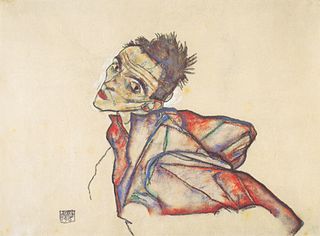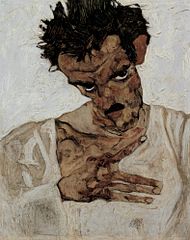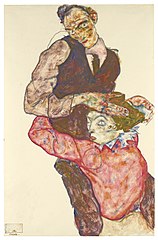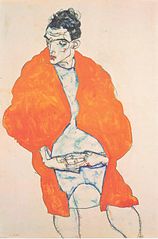
Egon Schiele
self-portraits

The short and intense career of Austrian figurative expressionist painter Egon Schiele was incredibly productive resulting in a treasure trove of masterful creations. Among his numerous oils, watercolors and drawings the subjects that stand out the most are self-portraits, portraits, nudes and landscapes. Schiele's style, life and unusually frequent use of his own body as a subject matter earned him a reputation of a bad boy of art and an egoist. Schiele's art and particularly his self-portraits are psychologically complex, emotionally and sexually direct, and intensely personal. Making a step further from his already daring work Schiele's nude self-portraits bring his art to a whole new level of honesty and intensity of emotions while using figural distortion as a tool to challenge conventional ideals of beauty.
One of Shiele's most famous and best known self-portraits is the Self-Portrait with Physalis. This masterpiece, painted in 1912 when the artist was 22 years old showcases a perfectly balanced composition and shows him as simultaneously self-confident and fragile allowing us to connect with him on a deep personal level.
"I am so rich that I must give myself away."

Egon Schiele's Life Timeline
- On 12 June 1890 Schiele was born in Tullin, Austria.
- A child of a station master, he was fascinated by trains and spent many hours drawing them.
- As a teenager he was shy and reserved. With an exception of athletics and drawing he did poorly at school.
- In 1905 his father died. This was the first great drama of his life.
- Following his father's death he became a ward of his uncle Leopold Czihaczek who recognized young Schiele's talent and allowed him an art tutor.
- In 1906 he started attending an art school in Vienna.
- The great Gustav Klimt took an interest in Schiele's work in 1907 and started helping him establish himself as an artist.
- In 1908 Schiele had his first exhibition.
- Schiele left art school in 1909 after completing his third year there.
- Rid of the constraints of school he began to explore human form and sexuality. At the time many observers found his creations disturbing.
- In 1910 Schiele painted the Kneeling Nude with Raised Hands which is now considered the most significant nude art piece of the 20th century.
- In 1911 twenty one year old Schiele met and fell in love with seventeen year old Wally. They soon started living together. She was the model for some of his most impressive paintings. They moved to southern Bohemia, but were soon driven out by residents who disapproved of their lifestyle.
- Schiele was arrested in 1912 for seducing and abducting Wally at the time when she was below the age of consent. Although these charges were dropped, he was found guilty of exhibiting erotic drawings. He served twenty four days in prison and created a series of 12 watercolors depicting the difficulties and discomfort of being locked in jail.
- In 1914 he met Edith Harms and decided to marry her while expecting to continue the relationship with Wally. Upon hearing of his intentions Wally immediately left him and he never saw her again.
- Schiele married Edith in 1915.
- In June of 1915 he was drafted into the army. He served as a prison guard and a clerk. During his time in the army he continued to paint and exhibit his art.
- By 1917 he was back in Vienna and fully focused on his artistic career.
- In 1918 Schiele participated in the Secession's 49th exhibition and experienced a triumphant success.
- In the fall of 1918 six months pregnant Edith died of Spanish flu.
- Three days later, on October 28th of 1918 Schiele died of Spanish flu at the age of only 28.






